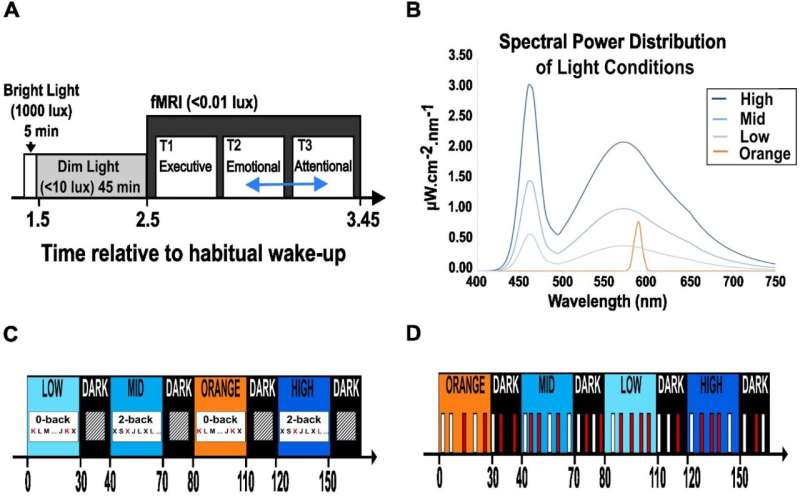
Exposure to higher levels of light can help people feel more awake and increase cognitive performance, probably by influencing the activity of parts of a brain region called the hypothalamus, according to new research.
The study, published in eLife, is described by the editors as of fundamental importance, and represents a key advancement to our understanding of how different levels of light affect human behavior. The strength of evidence is praised as compelling, supporting the authors’ analyses of the complex interplay between light exposure, hypothalamic activity, and cognitive function.
With further research, the findings could be used to inform various light therapy treatments to increase an individual’s quality of sleep and affective state, and help them feel more awake and perform tasks better throughout the day.
The biological effects of light exposure have been well documented in recent years. Higher illuminance has been shown to stimulate alertness and cognitive performance. These effects primarily rely on a subclass of light-sensitive cells in the retina, called ipRCGs.
These cells project to multiple areas of the brain, but projections are most densely found within the hypothalamus, which is typically associated with the regulation of circadian rhythms, sleep and alertness, and cognitive functions. However, this knowledge of the brain circuitry underlying the biological effects of light has almost entirely stemmed from studies in animals.
“Translating findings on how light exposure affects the brain in animal models to humans is a difficult process, as the later maturation of the cortex in human beings enables much more complex cognitive processing,” explains lead author Islay Campbell, former Ph.D. student at the GIGA-CRC Human Imaging—now awarded her doctorate—University of Liège, Belgium. “In particular, the question of whether hypothalamus nuclei contribute to the stimulating impact of light on cognition is not established.”
To better understand the impact of light on human cognition, Campbell and colleagues recruited 26 healthy young adults to participate in their study. They asked each participant to complete two auditory cognitive tasks; an executive task modified from the “n-back task” in which participants were asked to determine whether a current sound was identical to the one they heard two items earlier, or contained the letter “K”; and an emotional task, in which participants were asked to identify the gender of a voice that was either pronounced in a neutral tone or in an angry tone.
Each task was completed while the individuals were alternatively placed in darkness, or exposed to short periods of light in four levels of illumination. The team used a technique called 7 Tesla functional magnetic resonance imaging, which has a higher resolution and signal-to-noise ratio compared with standard 3 Tesla MRI, to assess the impact of the different light levels on the activity of the hypothalamus during the tasks.
The researchers found that during both tasks, higher levels of light triggered an increase in activity over the posterior hypothalamus. In contrast, the inferior and anterior hypothalamus followed a seemingly opposite pattern, exhibiting decreased activity under higher levels of light.
Next, the team sought to determine whether these changes in regional hypothalamus activity were related to a change in cognitive performance. They focused on assessing the participants’ performance during the executive task, as this required a higher level of cognition to solve. Their analysis revealed that higher levels of light indeed led to better performance in the task, indicating an increase in cognitive performance.
Importantly, the increase in cognitive performance under higher illuminance was found to be significantly negatively correlated with the activity of the posterior hypothalamus. This makes it unlikely that the posterior hypothalamus activity directly mediates the positive impact of light on cognitive performance, and possibly hints at other brain regions being involved, requiring further research.
On the other hand, the activity of the posterior hypothalamus was found to be associated with an increased behavioral response to the emotional task. This suggests that the association between cognitive performance and the activity of the posterior hypothalamus may be context dependent—in some tasks, certain hypothalamus nuclei or neuronal populations may be recruited to increase performance, but not in others.
The authors call for future work in this area to assess the impact of light on other structures, or entire networks of the brain to determine how varying light levels modify their crosstalk and interactions with the cortex to bring about behavioral changes.
“The questions that remain from our study are important to answer, because acting on light stands as a promising easy to implement means to reduce fatigue throughout the day, improving cognitive defects and allowing a restful night’s sleep with minimal cost and side effects,” says Campbell.
“Our results demonstrate that the human hypothalamus does not respond uniformly to varying levels of light while engaged in a cognitive challenge,” says senior author, Gilles Vandewalle, co-director of the GIGA-CRC Human Imaging, University of Liège. “Higher levels of light were found to be associated with higher cognitive performance, and our results indicate that this stimulating impact is mediated, in part, by the posterior hypothalamus. This region is likely to work jointly with the decreased activity of the anterior and inferior hypothalamus, along with other non-hypothalamus brain structures that regulate wakefulness.”
“Targeted lighting for therapeutic use is an exciting prospect. However, it will require a more comprehensive understanding of how light affects the brain, particularly at the subcortical level. Our findings represent an important step towards this goal, at the level of the hypothalamus,” notes Campbell.
More information:
Islay Campbell et al, Regional response to light illuminance across the human hypothalamus, eLife (2024). DOI: 10.7554/eLife.96576.1
Citation:
Higher light levels may improve cognitive performance (2024, April 23)
higher-cognitive.html
.
. The content is provided for information purposes only.
